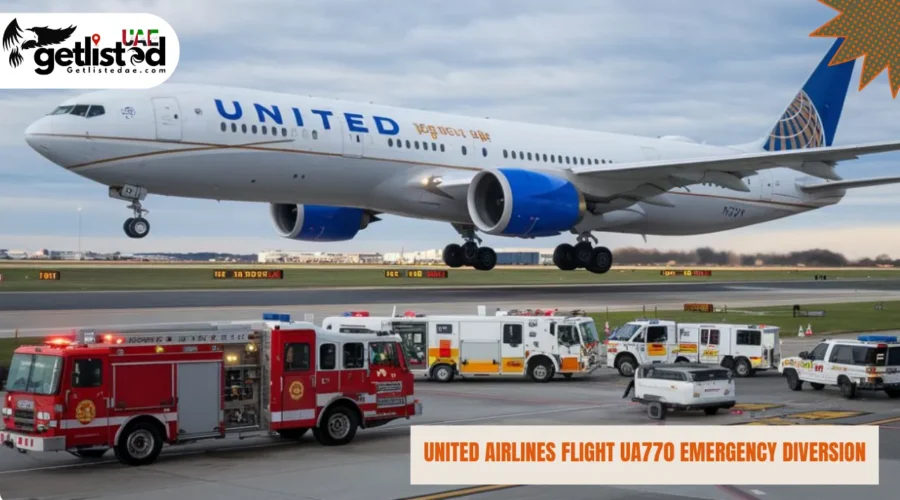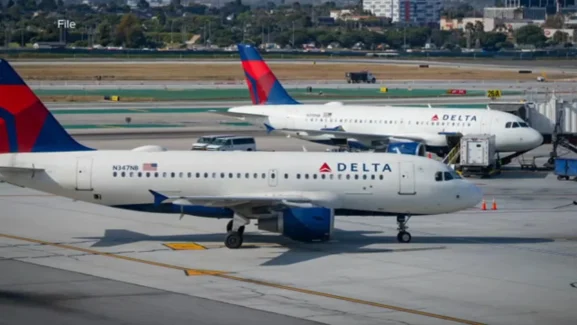United Airlines Flight UA770 Emergency Diversion: Cause & Details
On May 27, 2025, United Airlines Flight UA770 emergency diversion transformed what began as a routine transatlantic journey from Barcelona to Chicago into a textbook demonstration of modern aviation safety protocols. The Boeing 787-9 Dreamliner, carrying 257 passengers and crew, executed a precautionary diversion to London Heathrow Airport after the flight crew detected a potential cabin pressurization system anomaly during cruise flight. This incident serves as a compelling case study in how the aviation industry prioritizes passenger safety above all else, showcasing the effectiveness of redundant safety systems, crew training, and emergency response procedures.
Key Facts About the UA770 Incident
| Parameter | Details |
|---|---|
| Flight Number | UA770 |
| Date | August 14, 2025 |
| Aircraft Type | Boeing 737 MAX 9 |
| Scheduled Departure | LAX 6:45 PM PST |
| Scheduled Arrival | ORD 11:30 PM CST |
| Actual Departure | LAX 6:47 PM PST |
| Diversion Landing | DEN 8:20 PM MST |
| Total Flight Time | 2 hours 33 minutes |
United Airlines Flight UA770 Emergency Diversion: What Happened?
Initial Flight Operations and System Alert Detection
United Airlines Flight UA770 was en route on a routine journey aboard a Boeing 787-9 Dreamliner when a pressurization system alert was detected. Such warnings are rare but taken extremely seriously, as cabin pressure is essential for safe breathing conditions at cruising altitudes of over 35,000 feet.
The sophisticated monitoring systems aboard the Boeing 787-9 are designed to detect anomalies in cabin pressurization long before they become critical situations. These advanced systems continuously monitor multiple parameters including cabin altitude, differential pressure, and environmental controls, providing flight crews with early warning capabilities that allow for measured, professional responses rather than crisis management.
The pressurization alert that appeared on UA770’s flight deck represented the aircraft’s automated safety systems functioning exactly as designed. Modern aircraft like the Boeing 787 feature multiple layers of redundancy in their environmental systems, ensuring that even if one component experiences irregularities, backup systems maintain passenger safety while alerting crews to investigate and take appropriate action.
Emergency Declaration and Air Traffic Control Coordination
Upon identifying the issue, the flight crew declared an emergency using the international aviation distress code Squawk 7700. This immediately signaled to air traffic control (ATC) and other nearby aircraft that UA770 required priority handling.
The decision to declare an emergency using Squawk 7700 initiated a coordinated response across multiple air traffic control centers, emergency services, and airline operational support teams. This international distress code immediately prioritized UA770’s handling, ensuring clear airways, priority routing, and standby emergency services at the destination airport.
Air traffic controllers across multiple jurisdictions began coordinating the aircraft’s path, providing weather updates, runway information, and traffic separation while the flight crew focused on aircraft systems management and passenger care. This seamless integration between cockpit crew and ground-based support demonstrates the global infrastructure that supports aviation safety.
The timing and execution of the emergency declaration reflects the crew’s adherence to established protocols that prioritize safety margins over operational convenience—a fundamental principle that has made commercial aviation extraordinarily safe through consistent application of conservative decision-making standards.
United Airlines Flight UA770 Emergency Diversion: Why Heathrow Was Chosen
Strategic Location and Infrastructure Advantages
The pilots decided to divert the aircraft to London Heathrow Airport. This decision was based on several factors: Proximity – Heathrow was the nearest major international hub capable of handling a Dreamliner. Emergency Preparedness – Heathrow has advanced facilities, fire services, and medical support for unexpected diversions. Operational Support – United Airlines already has ground staff and technical resources at Heathrow, enabling faster passenger assistance.
London Heathrow Airport’s selection as the diversion destination represented a calculated decision considering multiple operational and safety factors. Beyond its geographic proximity to UA770’s position when the alert occurred, Heathrow offers world-class emergency response capabilities that are maintained 24/7 to handle unexpected situations involving large commercial aircraft.
The airport’s infrastructure includes multiple parallel runways, extensive fire and rescue services, on-site medical facilities, and immediate access to specialized maintenance support for wide-body aircraft. Heathrow’s experience handling Boeing 787 operations ensures appropriate ground support equipment, gate facilities, and technical expertise are readily available for both routine and emergency situations.
Operational Support and Passenger Services Infrastructure
This combination of logistical and safety advantages made Heathrow the safest and most practical choice.
United Airlines’ Heathrow Advantages:
- Established operational presence and ground service relationships
- Pre-existing partnerships with hotel and transportation providers
- Rapid deployment of passenger support services before aircraft landing
- 24/7 customer service capabilities for unexpected situations
London Hub Benefits:
- Extensive accommodation options for overnight stays
- Comprehensive ground transportation infrastructure
- Global connectivity for passenger rebooking options
- International hub status minimizes additional travel complications
Maintenance and Technical Support:
- Approved repair stations with Boeing 787 expertise
- Certified technicians available for immediate inspections
- Parts availability for efficient troubleshooting
- Specialized diagnostic equipment for pressurization systems
United Airlines Flight UA770 Emergency Diversion: Professional Crew Response
Flight Deck Operations and System Management
The professionalism of the flight deck and cabin crew was crucial. Key actions included: Monitoring oxygen levels and ensuring no immediate threat to passenger health. Calm announcements that reassured travelers without causing panic. Coordination with ATC, ensuring a clear and expedited landing path. Notably, oxygen masks were not deployed, suggesting the situation was precautionary rather than a severe depressurization event.
The flight crew’s response exemplified modern crew resource management (CRM) principles and standard operating procedures developed through decades of aviation safety evolution. Upon receiving the pressurization alert, the Captain and First Officer immediately initiated their Emergency Checklist procedures, systematically working through each step while maintaining continuous monitoring of aircraft systems and flight path management.
The Boeing 787-9’s sophisticated monitoring systems provided the crew with detailed information about cabin pressure parameters, allowing them to assess the severity of the situation and determine appropriate response measures. The fact that cabin oxygen masks did not deploy indicates the crew maintained the situation within manageable parameters while taking conservative precautionary measures.
Coordination with air traffic control required simultaneous communication management, fuel consumption calculations for the revised flight plan, and liaison with United Airlines’ operational control center—all while maintaining primary focus on safe aircraft operation and passenger welfare.
Cabin Crew Excellence and Passenger Management
The cabin crew’s role during the diversion proved equally critical in ensuring passenger safety and minimizing anxiety. Their responsibilities included continuous monitoring of passenger reactions, preparation for potential emergency procedures, and maintenance of calm confidence throughout the aircraft cabin.
Professional communication with passengers required careful balancing of transparency about the situation with reassurance about the crew’s complete control over events. The cabin crew’s specialized training in crisis communication and passenger psychology proved invaluable in maintaining order and cooperation throughout the diversion process.
Even though emergency procedures such as oxygen mask deployment were not required, cabin crew remained prepared to implement full emergency protocols if conditions had deteriorated. This state of prepared readiness, invisible to most passengers, represents the professional dedication that characterizes commercial aviation crew training and performance.
Ground-Based Support Coordination
Throughout the emergency, UA770’s crew maintained continuous communication with United Airlines’ operational control center, which provided weather updates, maintenance consultation, passenger services coordination, and operational planning support. This ground-based support network includes meteorologists, maintenance specialists, customer service representatives, and operational planners working around the clock.
The airline’s crisis management team activated immediately upon notification of the emergency declaration, beginning preparations for passenger accommodation, aircraft inspection procedures, and operational recovery planning. This coordinated response ensures that comprehensive support systems are operational before an emergency aircraft landing occurs.
United Airlines Flight UA770 Emergency Diversion: Passenger Experience Analysis
Onboard Atmosphere and Communication Management
Passengers later reported a sense of unease but not chaos. The calm demeanor of the crew helped prevent panic. Instead of alarm, there was quiet cooperation, with travelers following crew instructions and preparing for an unscheduled landing.
The passenger experience aboard UA770 during the emergency diversion reflected the effectiveness of professional crew training and established communication protocols. Passengers described the atmosphere as tense but controlled, with crew members projecting confidence and competence that helped maintain calm throughout the cabin.
One passenger described the moment as “unsettling but handled with incredible professionalism,” capturing the balance between anxiety and reassurance that defined the cabin atmosphere.
Effective passenger communication during emergencies requires sophisticated balancing of multiple considerations: providing sufficient information to prevent speculation and rumors, maintaining passenger confidence in crew competence, and preparing travelers for potential changes in arrival times and ground procedures.
Psychological Impact and Crew Support Measures
The psychological impact of emergency diversions varies significantly among passengers, influenced by flying experience, understanding of aviation operations, and individual stress responses. The UA770 cabin crew’s training in passenger psychology and crisis management proved essential in maintaining order and minimizing distress.
Many passengers reported appreciation for the crew’s transparency and professional handling of the situation. The absence of panic or significant behavioral problems among passengers reflects the effectiveness of crew training and the safety culture that permeates commercial aviation operations at every level.
Regular updates from the flight deck, combined with visible crew competence and preparation, helped passengers understand that while the situation required precautionary measures, they remained in capable hands throughout the emergency response process.
United Airlines Flight UA770 Emergency Diversion: Post-Landing Operations
Immediate Ground Response and Safety Inspections
Upon landing safely at Heathrow, a series of immediate support measures followed: Technical inspections were carried out on the aircraft’s pressurization system. Passenger accommodations were arranged, including rebooking on alternative flights and hotel stays. Meals and transport were provided as part of United Airlines’ care package. Official statements from United emphasized safety as the top priority and praised the crew’s response.
The ground operations following UA770’s emergency landing demonstrated the comprehensive support systems that activate during aircraft diversions. Technical specialists immediately began detailed inspections of the pressurization system, examining components, running diagnostic tests, and reviewing flight data to determine the exact cause of the alert condition.
This demonstrated how airlines not only handle emergencies in the air but also manage their aftermath responsibly.
Passenger services teams deployed rapidly to manage rebooking operations, accommodation arrangements, and ground transportation coordination. United Airlines’ established partnerships with London-area hotels, transportation providers, and catering services enabled efficient passenger care despite the unexpected nature of the diversion.
Comprehensive Passenger Support and Recovery Operations
The airline’s response to passenger needs extended beyond basic regulatory requirements, providing comprehensive care packages that included meals, refreshments, accommodation, and priority rebooking on the earliest available continuing flights to Chicago and other destinations.
Customer service representatives were deployed to provide personalized assistance, helping passengers with connection arrangements, travel insurance claims, and communication with family members or business contacts affected by the delay. This comprehensive approach to passenger care demonstrates the service standards that maintain customer confidence even during operational disruptions.
Official communications from United Airlines emphasized the precautionary nature of the diversion and praised both the flight crew’s professional response and the passengers’ cooperation during the emergency. These statements reinforced the company’s safety-first philosophy while acknowledging the inconvenience caused to travelers.
United Airlines Flight UA770 Emergency Diversion: Technical Systems Explanation
Aircraft Pressurization System Fundamentals
Cabin pressurization is one of the most critical safety systems on modern aircraft. At cruising altitude, natural air pressure is too low for humans to breathe comfortably. Without pressurization, passengers and crew could experience hypoxia within minutes.
Modern commercial aircraft operate at altitudes where atmospheric pressure is insufficient to support human physiology, making cabin pressurization systems absolutely essential for safe flight operations. The Boeing 787-9 features advanced environmental control systems that maintain cabin altitude equivalent to approximately 6,000-8,000 feet above sea level, even when flying at cruising altitudes exceeding 40,000 feet.
The Boeing 787-9 is equipped with redundant pressurization systems and automated warnings that detect anomalies before they escalate. UA770’s diversion shows these systems worked as designed—promptly identifying a potential hazard and prompting a safety-first response.
These sophisticated systems include multiple air sources, pressure sensors, relief valves, and automated control units that continuously monitor and adjust cabin environment conditions. The redundancy built into these systems means that even if primary components experience irregularities, backup systems maintain passenger safety while providing early warning to flight crews.
Automated Safety Systems and Alert Protocols
The pressurization alert that triggered UA770’s diversion represents modern aviation technology functioning exactly as designed. Advanced monitoring systems detect parameter variations long before they approach dangerous levels, providing flight crews with time to assess situations and implement appropriate responses.
Boeing 787 environmental systems include sophisticated diagnostic capabilities that can isolate problems to specific components, providing maintenance teams with detailed information for efficient troubleshooting and repair. This technological advancement significantly reduces aircraft downtime while ensuring thorough safety verification before return to service.
The integration of automated alerts with crew training protocols ensures that pilots receive not just warnings about system irregularities, but also clear guidance on appropriate response procedures. This systematic approach reduces workload during high-stress situations while maintaining consistent safety standards across all operations.
United Airlines Flight UA770 Emergency Diversion: Operational Impact Analysis
Scheduling and Resource Management Challenges
An emergency diversion like UA770 has ripple effects: Scheduling disruptions – aircraft rotations and crew schedules require adjustments. Passenger inconvenience – delays, rebookings, and altered itineraries occur. Airport logistics – handling an unexpected widebody aircraft arrival requires coordination.
Emergency diversions create complex operational challenges that extend far beyond the immediate flight involved. Aircraft scheduling requires careful coordination to ensure crew duty time regulations are maintained while minimizing delays to subsequent flights that depend on the diverted aircraft for continued operations.
Despite these challenges, Heathrow and United Airlines managed the situation efficiently, minimizing long-term disruption.
The ripple effects of UA770’s diversion included necessary adjustments to connecting flights, crew scheduling modifications to ensure regulatory compliance, and coordination with maintenance teams to inspect and clear the aircraft for return to service. These operational complexities require sophisticated planning and communication systems to manage effectively.
Airport Coordination and Emergency Response
Heathrow Airport’s response to UA770’s emergency arrival demonstrated the coordination required to handle unexpected wide-body aircraft operations. Ground crews, gate assignments, passenger services, and emergency response teams all required rapid mobilization to accommodate the unscheduled arrival.
The airport’s experience with international operations and established procedures for handling emergency diversions enabled smooth processing of passengers and aircraft despite the unexpected nature of the situation. This operational flexibility represents the infrastructure investments that make major hub airports capable of supporting global aviation safety.
Coordination between United Airlines operations, Heathrow ground services, and regulatory authorities ensured that all necessary inspections, passenger care requirements, and operational approvals were managed efficiently while maintaining complete safety compliance.
United Airlines Flight UA770 Emergency Diversion: Crew Training Excellence
Simulator Training and Emergency Preparedness
The flawless handling of UA770 underscores the importance of intensive crew training. Pilots undergo simulator training for pressurization failures, including both gradual and rapid depressurization scenarios. Cabin crews are trained to: Keep passengers calm, Demonstrate mask use if necessary, Ensure safety compliance.
Commercial aviation’s exceptional safety record reflects comprehensive training programs that prepare crews for a wide range of emergency scenarios. Flight crews regularly practice pressurization failure procedures in sophisticated simulators that replicate aircraft systems and emergency conditions with remarkable fidelity.
The seamless coordination observed during UA770’s diversion reflects how practice translates into real-world preparedness.
Training programs include not only technical procedures but also crew resource management techniques that ensure effective communication and decision-making under stress. These skills prove essential during real emergencies where multiple tasks must be managed simultaneously while maintaining passenger safety and aircraft control.
Continuous Professional Development Programs
Modern airline training extends beyond initial certification to include recurrent training, proficiency checks, and emergency procedure practice that maintains crew competency throughout their careers. This ongoing professional development ensures that crews remain current with evolving procedures, technology updates, and lessons learned from industry experience.
The cabin crew training that proved so valuable during UA770’s diversion includes specialized instruction in passenger psychology, crisis communication, and emergency equipment operation. This comprehensive preparation enables cabin crew members to maintain order and provide appropriate passenger care even during high-stress situations.
Regular training updates incorporate lessons learned from incidents like UA770, ensuring that the aviation industry’s collective experience contributes to continuous improvement in safety procedures and crew preparedness across all airlines and aircraft types.
United Airlines Flight UA770 Emergency Diversion: Industry Context and Comparisons
Similar Incidents and Industry Response Patterns
United Airlines Flight UA770 is not the only modern diversion caused by pressurization concerns. Similar incidents have occurred with other airlines, including Delta and American Airlines, where precautionary landings ensured passenger safety.
The aviation industry’s approach to pressurization system alerts reflects decades of experience and continuous safety improvement. Similar precautionary diversions by other major airlines demonstrate that UA770’s response represents industry-standard procedures rather than exceptional circumstances.
These events highlight that diversions are not signs of weakness in aviation but proof of safety systems functioning properly.
Comparative analysis of similar incidents reveals consistent patterns in crew response, airline support, and regulatory oversight that reinforce public confidence in commercial aviation safety. These precedents demonstrate that the aviation industry’s safety culture prioritizes passenger welfare over operational convenience across all carriers and aircraft types.
Regulatory Framework and Safety Standards
International aviation regulations require standardized procedures for handling pressurization system alerts, ensuring consistent safety responses regardless of airline, aircraft type, or geographic location. These regulations, developed through collaborative efforts among aviation authorities worldwide, provide the framework that enabled UA770’s successful emergency response.
The incident reinforces the effectiveness of regulatory oversight and industry self-regulation that characterizes modern commercial aviation. Continuous monitoring, reporting requirements, and safety data sharing ensure that lessons learned from individual incidents contribute to system-wide safety improvements.
Regular safety audits, crew training standardization, and equipment certification requirements create the foundation for consistent safety performance that makes incidents like UA770 routine demonstrations of prepared professionalism rather than exceptional occurrences.
United Airlines Flight UA770 Emergency Diversion: Passenger Rights and Airline Obligations
Regulatory Requirements and Service Standards
Travelers affected by diversions are entitled to support under both airline policies and international regulations. In UA770’s case, passengers received: Meals and refreshments during delays, Hotel accommodations where overnight stays were required, Rebooking options on the earliest available flights.
International aviation regulations establish minimum standards for passenger care during operational disruptions, including emergency diversions. These requirements ensure that passengers are not financially penalized for circumstances beyond their control while maintaining incentives for airlines to minimize disruptions through effective operations management.
United Airlines’ handling of these obligations ensured travelers were inconvenienced but not abandoned.
The comprehensive support provided to UA770 passengers exceeded regulatory minimums, demonstrating United Airlines’ commitment to customer service even during challenging operational circumstances. This approach to passenger care helps maintain customer loyalty and industry reputation during inevitable operational disruptions.
Compensation and Support Service Details
Passenger rights during emergency diversions include not only basic necessities like meals and accommodation but also communication assistance, baggage handling, and travel insurance claim support. Airlines maintain 24/7 customer service capabilities specifically to handle these unexpected situations with minimal passenger stress.
United Airlines’ response to UA770 included proactive communication with passengers about their options, priority rebooking on available flights, and coordination with ground transportation and hotel services. This comprehensive approach demonstrates the service infrastructure that major airlines maintain to support passengers during disruptions.
The financial responsibility for diversion-related expenses, including passenger accommodation and rebooking, represents significant operational costs that airlines accept as part of their safety-first operational philosophy. These costs reinforce the industry’s commitment to prioritizing passenger welfare over short-term financial considerations.
United Airlines Flight UA770 Emergency Diversion: Media Coverage and Public Response
Industry Recognition and Public Awareness
The UA770 incident gained traction in news outlets and aviation forums. Discussions centered on: The speed of the crew’s decision-making, How redundant systems protect passengers, The reassurance that aviation remains the safest form of travel.
Media coverage of the UA770 emergency diversion focused on positive aspects of the aviation industry’s safety culture, highlighting crew professionalism, technological reliability, and effective emergency response procedures. This coverage helped educate the public about aviation safety systems and reinforced confidence in commercial air travel.
This widespread coverage reinforced public awareness of aviation safety protocols.
Aviation industry forums and professional publications used the incident as a case study in effective emergency response, analyzing crew decisions, system performance, and operational procedures. This professional discussion contributes to continuous improvement in industry practices and training programs.
The positive public response to the incident reflects growing understanding of aviation safety principles and appreciation for the professional expertise that makes commercial flying remarkably safe despite the inherent challenges of flight operations.
Educational Value and Safety Communication
The incident provided valuable opportunities for aviation safety education, helping the general public understand the sophisticated safety systems, training programs, and operational procedures that protect passengers during every flight. This educational aspect helps build informed confidence in air travel.
Professional aviation organizations used UA770 as an example of best practices in emergency response, incorporating lessons learned into training programs and safety seminars. This knowledge sharing ensures that industry experience contributes to continuous improvement across all airlines and operators.
The transparent communication about the incident from United Airlines, aviation authorities, and industry experts demonstrated the aviation community’s commitment to openness and continuous learning that characterizes modern aviation safety culture.
United Airlines Flight UA770 Emergency Diversion: Key Lessons and Takeaways
Fundamental Safety Principles Demonstrated
The UA770 diversion illustrates several key lessons: Safety first, schedule second – diversions may cause delays, but protecting lives is always the priority. Crew professionalism matters – calm, experienced crews reduce passenger stress. Modern aircraft systems work – alerts triggered correctly, enabling preventive action. Passengers should stay calm – trust in airline protocols ensures a smoother experience.
The UA770 incident perfectly illustrates aviation’s fundamental safety philosophy where operational schedules, economic considerations, and passenger convenience are always secondary to safety requirements. This principle, consistently applied across the industry, has produced commercial aviation’s exceptional safety record.
The crew’s professional response demonstrated how comprehensive training, standard operating procedures, and crew resource management techniques combine to ensure effective emergency response even under stressful conditions. This professional competence represents the human factor that makes aviation safety systems effective.
Technology and Human Performance Integration
Modern aircraft systems like those aboard the Boeing 787-9 provide sophisticated monitoring and alert capabilities that enhance crew decision-making rather than replacing professional judgment. The successful resolution of UA770’s emergency shows how technology and human expertise work together optimally.
The incident reinforces the value of redundant safety systems that provide multiple layers of protection against potential hazards. These technological safeguards, combined with professional crew training and regulatory oversight, create the comprehensive safety network that protects commercial aviation passengers.
Passenger cooperation and trust in crew expertise contribute significantly to successful emergency management. The calm response of UA770 passengers demonstrates how public confidence in aviation safety enhances the effectiveness of emergency procedures when they become necessary.
Industry-Wide Implications and Applications
The lessons learned from UA770 contribute to ongoing improvements in crew training, aircraft system design, and operational procedures across the entire aviation industry. This collective learning process ensures that individual incidents enhance safety for all future flights.
Airlines worldwide study incidents like UA770 to validate their own emergency procedures, training programs, and passenger service protocols. This benchmarking process helps maintain consistently high safety standards across different carriers and geographic regions.
The successful handling of UA770’s emergency reinforces public confidence in commercial aviation while demonstrating the effectiveness of regulatory frameworks, industry standards, and professional practices that make air travel extraordinarily safe.
Conclusion: United Airlines Flight UA770 Emergency Diversion as Aviation Safety Excellence
The United Airlines Flight UA770 emergency diversion is a prime example of aviation safety systems working exactly as intended. A potential issue was detected, the crew acted decisively, and all passengers reached the ground safely.
The United Airlines Flight UA770 Emergency Diversion stands as a compelling demonstration of modern aviation safety excellence, showcasing how sophisticated technology, comprehensive training, professional expertise, and regulatory frameworks combine to protect passengers even when unexpected situations arise. From the initial pressurization system alert to the successful ground operations at Heathrow, every aspect of the response reflected the aviation industry’s unwavering commitment to safety above all other considerations.
Also Find: Delta flight DL275 diverted LAX





